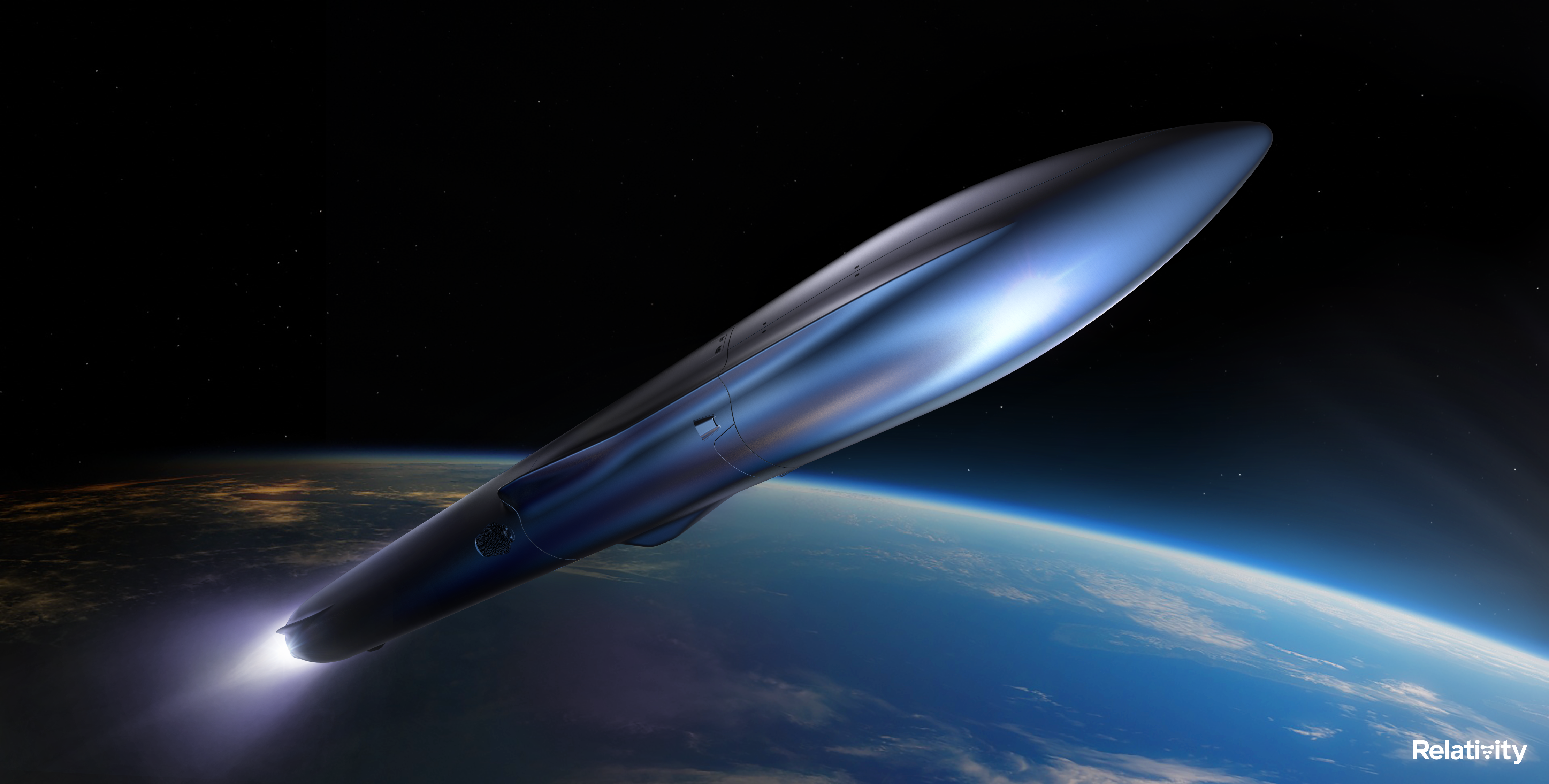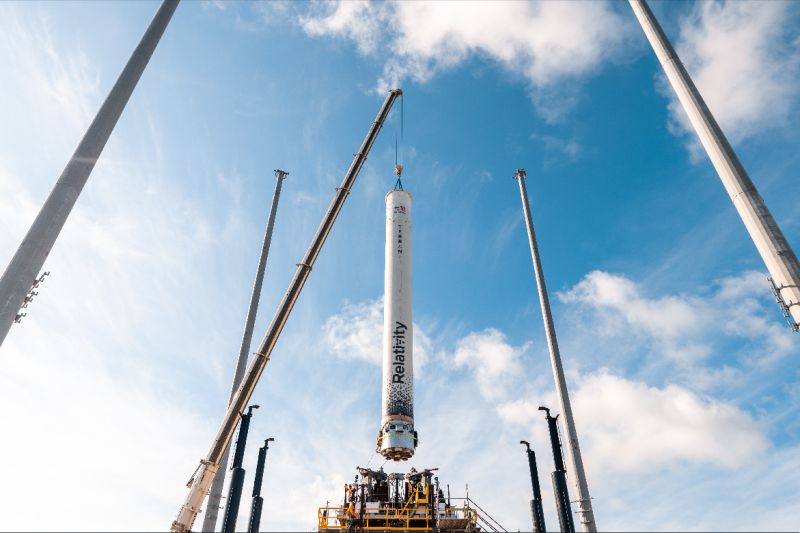Designed to redefine rocket manufacturing, the latest iteration of Relativity Space‘s proprietary additive manufacturing platform is the largest in the world. The company estimates that its Stargate Fourth Generation metal 3D printers will underpin both the development and rate production of Terran R, Relativity’s fully reusable, 3D printed rocket capable of launching 20,000 kg to low Earth orbit (LEO).
During the weekend, the rocket manufacturer had hinted that “something big” was coming, and all signs pointed to a new Stargate printer. News of a new generation 3D printing platform coincides with the company’s recently announced 150-acre expansion at NASA Stennis Space Center, which will also be dedicated to testing the brand’s entirely 3D printed Aeon R rocket engines set to power its fully reusable and 3D printed Terran R medium-lift launch vehicle.
 Relativity Space’s Terran R medium-lift launch vehicle will debut in 2024. Image courtesy of Relativity Space
Relativity Space’s Terran R medium-lift launch vehicle will debut in 2024. Image courtesy of Relativity SpaceAs the latest addition to a stellar history in metal 3D printing, the new system builds upon the success of previous Stargate printer models.
Founders Tim Ellis and Jordan Noone may not have been the first people to think of 3D printing an entire rocket–3D printed parts had already been launched aboard NASA rockets by the time the company made a name for itself–but their determination to bring the manufacturing costs of rockets down from the hundred million to just millions gave it the edge it needed from the start. That edge was Stargate. A massive 3D printer that can make its rockets with 100 times fewer parts in less than 60 days. Using several Kuka robotic arms onto which a laser is mounted and aluminum metal wire fed into the focal point of the laser, components can be 3D printed. To melt and fuse the material during the printing process, Stargate uses a high-powered laser and plasma arc technology.
The fourth-generation version of Stargate is powered by customized software, can print more complex, significantly larger metal products seven times faster than earlier-generation Stargate printers, and defies traditional printing constraints by moving horizontally instead of vertically, feeding multiple wires into a single print head. In addition, by increasing 55 times the volume capacity of Stargate third-gen printers, the new model can print objects up to 120 feet long and 24 feet wide.
With faster iteration cycles, Stargate printers can accelerate progress and innovation within the aerospace industry while radically simplifying manufacturing supply chains. Additionally, Relativity is developing customized software and machine learning techniques to allow these printers to print more complex and significantly larger metal products with improved print speed and reliability.
“Large-scale products that are designed to fly will inevitably be 3D printed,” said Ellis. “The lighter a product is, the better it performs, and when 3D printing that product, it’s also faster and more cost-effective to produce with each successive improvement. The compounding rate of progress is high, and we are still in the early days of what printing can achieve. We see 3D printing as an automation technology that has the power to change the pace of innovation in manufacturing, which is why we’ve invested in building our own proprietary tech stack from day one.”
Ellis also highlights that with Stargate printers, what would otherwise take traditional space manufacturers years to develop, will be reduced to months due to its highly adaptable, scalable, and automated process, made possible through software-driven manufacturing.
For now, Stargate 4th Generation printers will serve as the primary manufacturing infrastructure for Terran R production, creating significant cost reductions for customers downstream. Furthermore, most Terran R components will be printed inside Relativity’s new Long Beach headquarters, dubbed The Wormhole.
Currently 33% operational, the factory has several Stargate 4th Generation printers online, with more than a dozen printers planned to be producing Terran R components in the coming months. Each Stargate 4th Generation printer can produce four Terran R rockets per year at the total capacity forecasted run rate. The remainder of The Wormhole will continue to be built out in phases, bringing more printers online and moving more teams into the company’s headquarters as production for Terran R scales.
 First stage of Terran 1, the rocket from Relativity Space is entirely 3D printed. Image courtesy of Relativity Space.
First stage of Terran 1, the rocket from Relativity Space is entirely 3D printed. Image courtesy of Relativity Space.As part of its expansion strategy, Relativity also revealed that in the longer term, the Stargate 4th Gen printers would offer tremendous value-generating potential for other end-product use cases within the trillion-dollar aerospace, aviation, energy, and defense industries as the core of a new tech stack for aerospace products.
Straightaway, we can acknowledge that disrupting rocket manufacturing is in Relativity’s DNA, even though the company still hasn’t launched its first demo rocket. So far, it has successfully hot-fired all nine engines of its Terran 1 rocket together for the first time in July of this year. Currently, the first stage of Relativity’s Terran 1 is sitting at its Launch Complex 16 hangar in Port Canaveral, ready to carry out a mission duty cycle (MDC) test before the company integrates the first and second stages of the rocket. Then, in a few weeks, Relativity will make its debut flight in a mission called “Good Luck, Have Fun,” which will journey to orbit without any customer payload.
Once the demo launch is complete, Relativity team members will evaluate the insights from the mission and prepare for a second journey to space, this time as part of NASA’s Ventura Class Launch Services Demonstration 2 (VCLS Demo 2) contracts. Terran 1 also has other launch contracts with NASA and forthcoming rideshares from customers like Spaceflight, Iridium, and Momentus. Even though Terran R is still a couple of years away from an initial launch, Relativity has already sold $1.2 billion of launches, with customers like OneWeb and Impulse Space.
Subscribe to Our Email Newsletter
Stay up-to-date on all the latest news from the 3D printing industry and receive information and offers from third party vendors.
Print Services
Upload your 3D Models and get them printed quickly and efficiently.
You May Also Like
Johns Hopkins University Researchers Develop HyFAM Technology
Two scientists from Johns Hopkins University, Nathan C. Brown and Jochen Mueller, have developed a hybrid manufacturing technology they call HyFam, or Hybrid Formative Additive Manufacturing. Their work on this technology...
3D Printing G-Code Gets an Upgrade: T-Code
Good old G-Code still manages many 3D printers, great and small. Just like the STL, it’s a standard that enables collaboration while also holding the additive manufacturing (AM) industry back....
AM Rewind: The Biggest News and Trends of 2024
After a sluggish 2023, driven by persistent inflation and geopolitical tensions, 2024 has seen some recovery. Economic growth climbed from about 2.8 percent in 2023 to a modest 3.2 percent...
Metal Wire 3D Printer OEM ValCUN Announces Plans for 2025 Expansion
ValCUN, a Belgian original equipment manufacturer (OEM) of wire-based metal additive manufacturing (AM) hardware, has announced that the company has entered the next phase of its growth trajectory, making key...

































